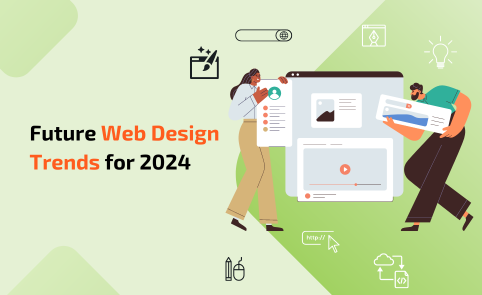A desire to stand out
After more than two decades of the internet, it makes sense that websites may
begin to look the same in their efforts to provide the best experience. Contrary to this, we expect
to see a rise in diversity in the coming year, with more websites using asymmetry to catch the eye
and big typography in place of meaningless stock photography. Companies are beginning to learn that
one size won’t fit all, and must strive to be memorable in order to attract new business.
Minimalist design will continue to grow too, using a combination of text,
space and bold colour to provide unique visuals that break away from the popular ‘black on white
space’ look. Couple this with the reserved use of parallax scrolling, a video background or
full-screen slider and you have the makings of a site that’s primed and ready for 2024.
An increase in speed and
performance
More important today than it was a few years ago, the speed of your website is
not only a key ranking factor, but paramount to actually having your content read at all. Google has
reportedly found that 53% of users will abandon a website after three seconds, which is a stark
warning to any slow movers looking to increase their consumer base in 2024.
Thankfully, this is a requirement that more businesses and developers are beginning to wake up to.
As such, we’re likely to see more websites that prioritise speed using smart, minimal code and
optimised imagery to reduce loading where possible.
The mobile web & progressive
web apps
Even if your website responds on handheld devices, it’s worth checking its
usability. With Google now placing greater emphasis on a site’s mobile version over its desktop
counterpart, a crudely designed website that’s technically mobile responsive will no longer cut it
long-term. The progressive web app (or PWA for short) is a fresh alternative to both the mobile web
and the native app, such as one you would download from an app store. The PWA has already been
picked up by the likes of Twitter, Forbes and The Washington Post and is in a very strong position
moving forwards.
The progressive web app uses less data than a native app, loads swiftly and can be seen in search
engines because it exists on the web. We have yet to see the upper limits of this technology, but
given their many selling points and few disadvantages, PWAs could easily become the most effective
answer to the responsive web in 2024.
Speaking of optimised imagery, we’ve seen a surge in websites presenting big, crisp images that look
fantastic on retina screens. This equates to a simple case of cause and effect – as technology
improves and the adoption rate rises, you inevitably see an increase in companies willing to target
that specific audience. This just means nicer imagery for all concerned.
While animation has graced many an ‘upcoming trends’ article and has yet to emerge as a web design
staple, it’s nonetheless something you can expect to see grow as time goes on. Most sites probably
won’t centre their entire content around fancy animations just yet, but you can expect to see them
used on a smaller, subtle scale that won’t distract too much from the main primary content.
Greater customer focus
While the push for appealing visuals will always be at the forefront of
design, recent times have seen a greater emphasis on the user-experience. Businesses are starting to
understand that an effective website needs to guide the user on a journey; one that’s held together
with tight content, few clicks and a powerful call-to-action. It’s at last becoming understood that
potential customers need to be sold on the company’s service, by persuading them that it can solve a
problem or fill a need in their lives.
The rise of the landing page is also very topical, as companies learn to advertise themselves and
attempt to convert hesitant users into paying customers. Essentially, we can expect to see greater
focus given to a website’s structure, with fewer menu tabs and less clicks needed to find relevant
content.
